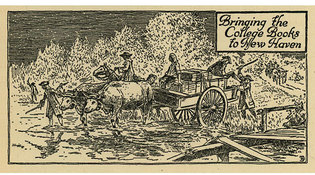 loading
loading
Old YaleHow Yale moved to New HavenThree hundred years ago, a small college decided to relocate. Judith Ann Schiff is chief research archivist at the Yale University Library.  Engraving by Theodore Diedricksen Jr.An engraving from Edwin Oviatt’s 1916 book The Beginnings of Yale offers a placid depiction of the college’s move from Saybrook to New Haven. In real life, saboteurs made the trip more difficult. View full imageThe most historically important minutes of the Yale Corporation noted the November 11, 1701, decision that “Erected & formed a Collegiate School, Wherein shall be taught the Liberal Arts, & Languages.” But second to that come the minutes of October 17, 1716. In that meeting 300 years ago, the trustees voted to remove the Collegiate School from Saybrook to New Haven “as a very Convenient place for it, and for which the Most Liberal Donations are given.” Saybrook, Connecticut, the first official site of Yale, was a compromise location. In 1701, New Haven became a co-capital, with Hartford, of the Connecticut Colony. The selection of Saybrook ensured that the school could go forward without conflict between the co-capitals. The school started, however, in Killingworth (now Clinton), ten miles from Saybrook. The first rector—head of the college and at the time its only teacher—was Reverend Abraham Pierson, whose Killingworth congregation refused to release him from his preaching contract. Only after his death in 1707 did the college settle in Saybrook. Once there, the school remained small; from 1707 through 1716, 40 BAs and 31 MAs were awarded. During 1714, donors in England sent the school more than 900 books. Now the need for a facility, with library space, was urgent. In May 1715 the trustees appealed to the colony’s assembly for “a suitable house.” At the same time, the new and inexperienced tutors were having trouble controlling the students. The college began to break apart: groups of students and tutors started meeting in Wethersfield and Guilford, while Samuel Andrew, rector pro tempore, stayed at his home in Milford. By the summer of 1716, only one tutor remained in Saybrook. But in October 1715 the assembly had awarded £500 to the college for a new building. A bidding war followed. New Haven, supported by three trustees and five other ministers, offered eight acres of land and raised £1,500 to £2,000. Saybrook, with the (temporary) support of two trustees, put up £1,200 to £1,400. Hartford, supported by two trustees, could muster only £700. At the last meeting in Saybrook, on September 12, 1716, the quorum of trustees voted five to two for New Haven. The move and the construction took time, and the new building was not occupied until the fall of 1718. The last hurdle was moving the books—and, since Saybrook’s inhabitants believed the books belonged to their town, it wasn’t an easy one. By December, their resistance had proved so effective that the county sheriff had to forcibly enter the house where the books were held and impress men, carts, and oxen to transport them. Then, the night before the journey started, residents broke the carts, turned the oxen loose, and destroyed some of the bridges along the route. Just over a thousand books ultimately arrived in New Haven; another 260 or so were said to have been lost or left behind in Saybrook. Saybrook had played a vital role in Yale’s history, as a safe harbor where the college could develop until it was strong enough to resist closure or control by crown or colony. But the “battle of the books” would be long remembered. Yale Glee Club director Marshall Bartholomew, Class of 1907S, included a song about it in his collection of Yale music:
The comment period has expired.
|
|